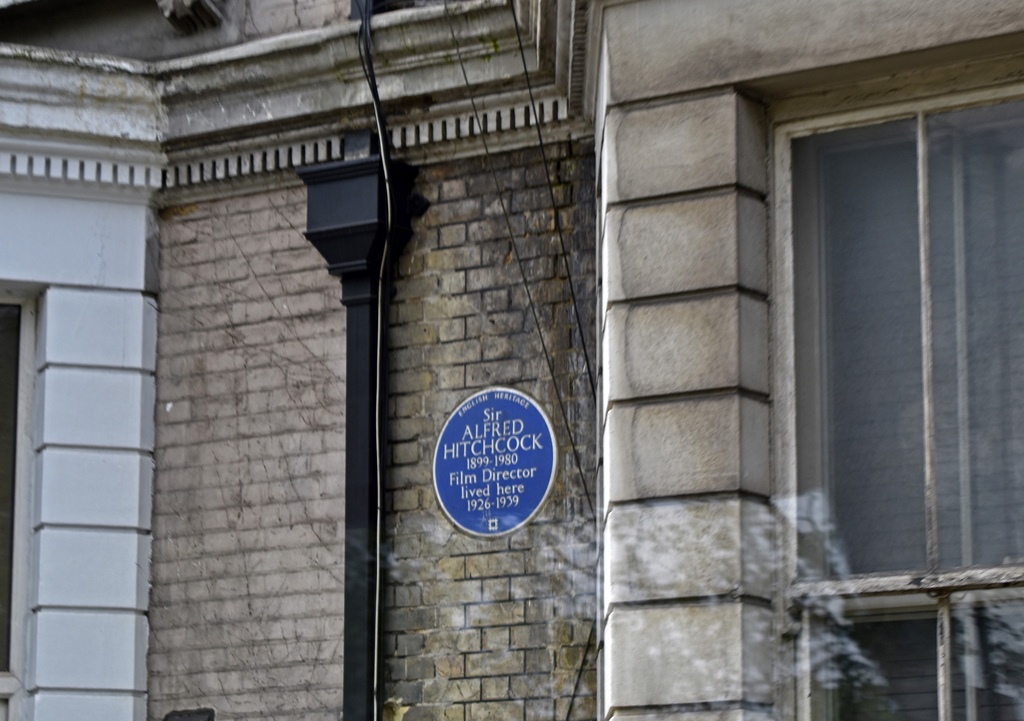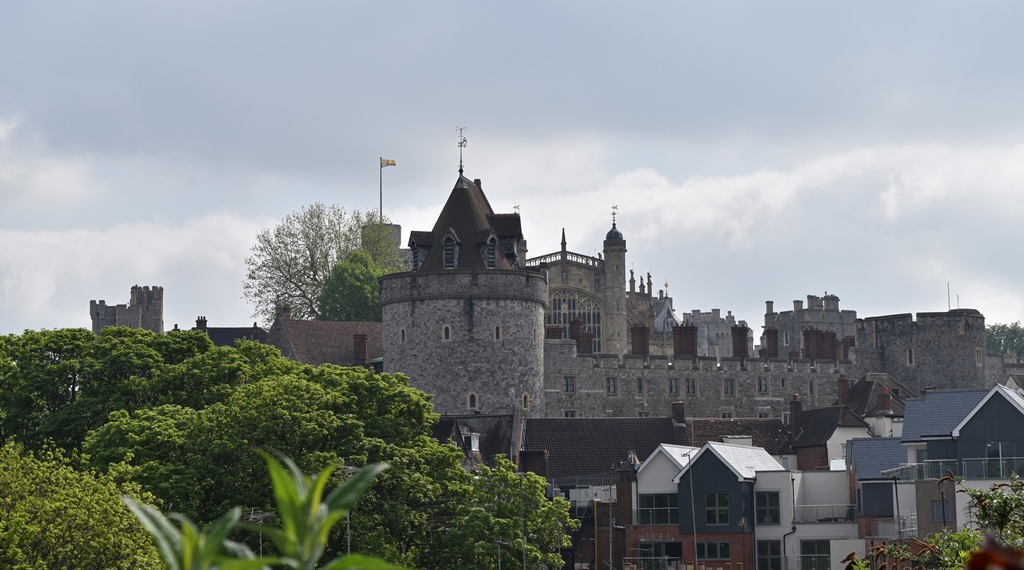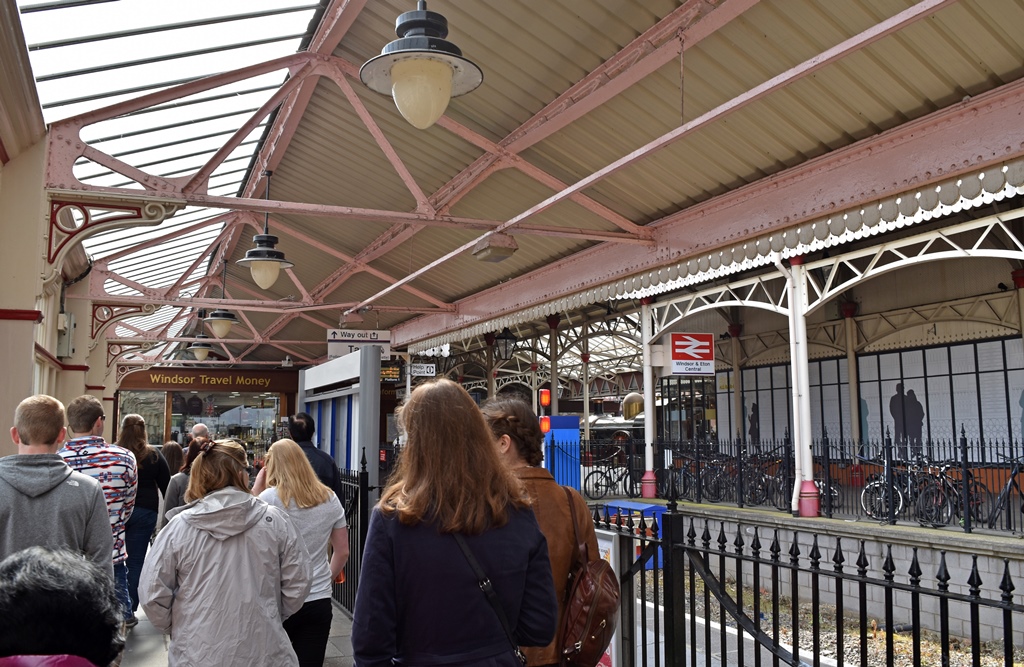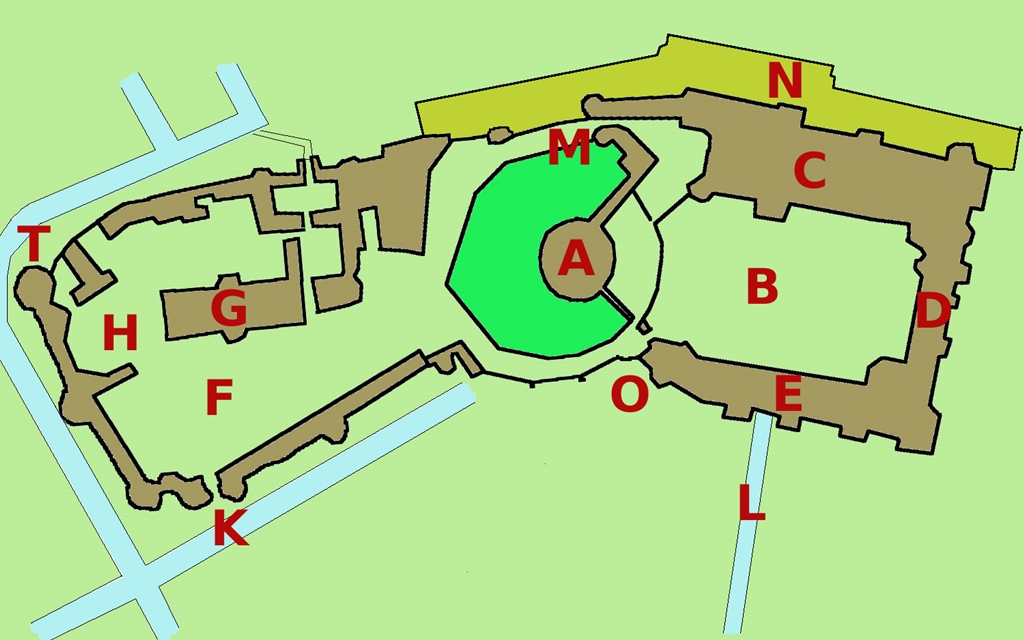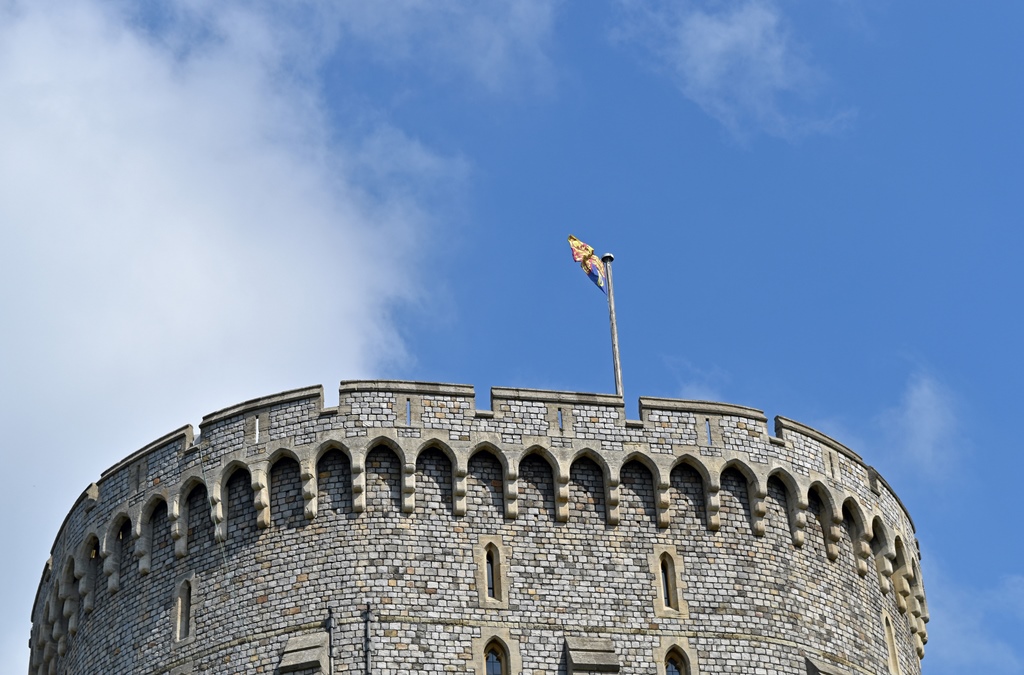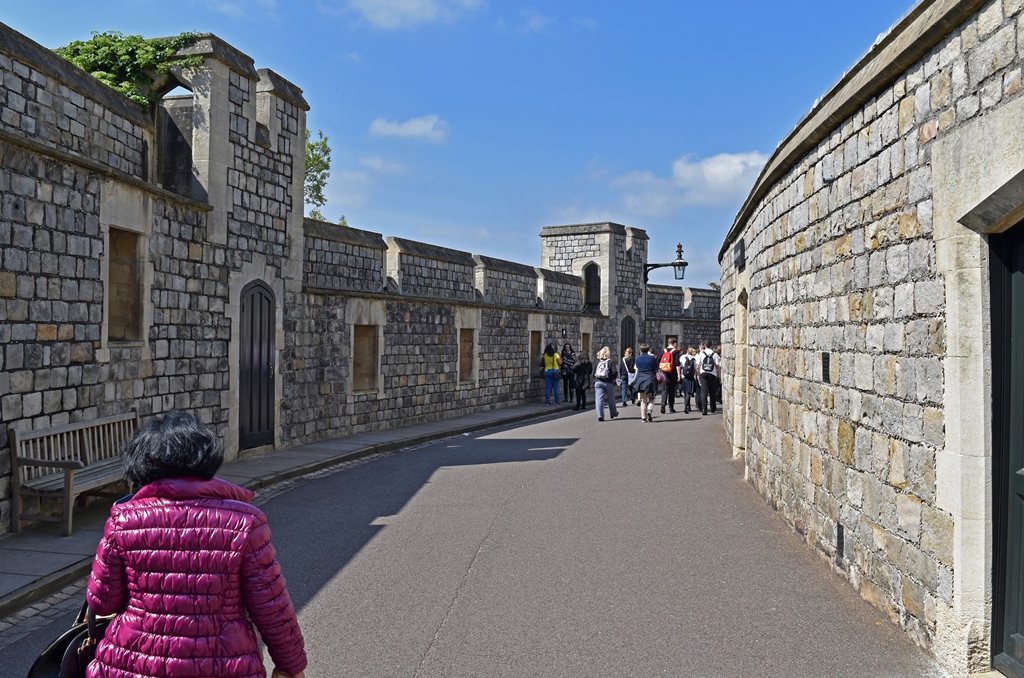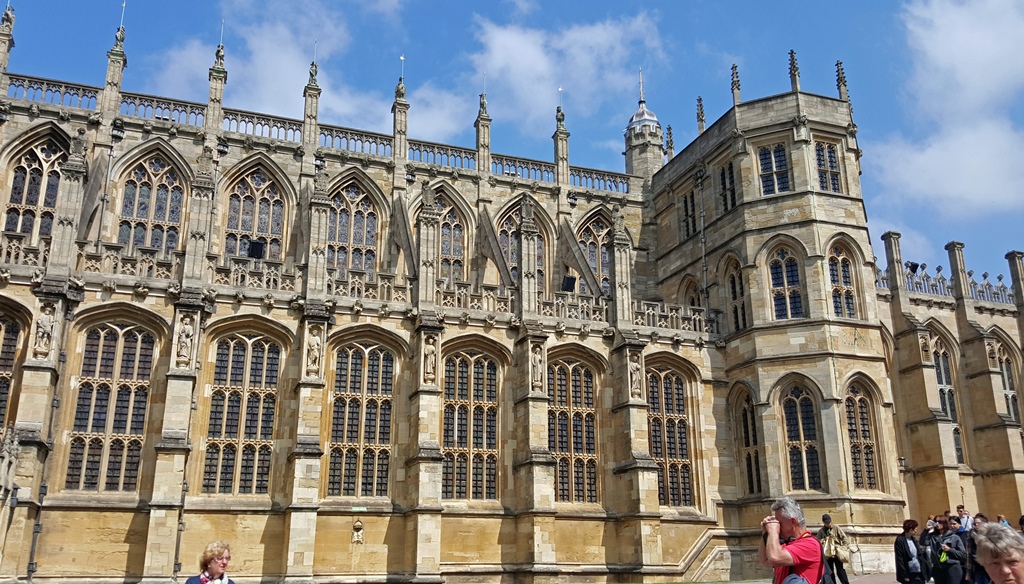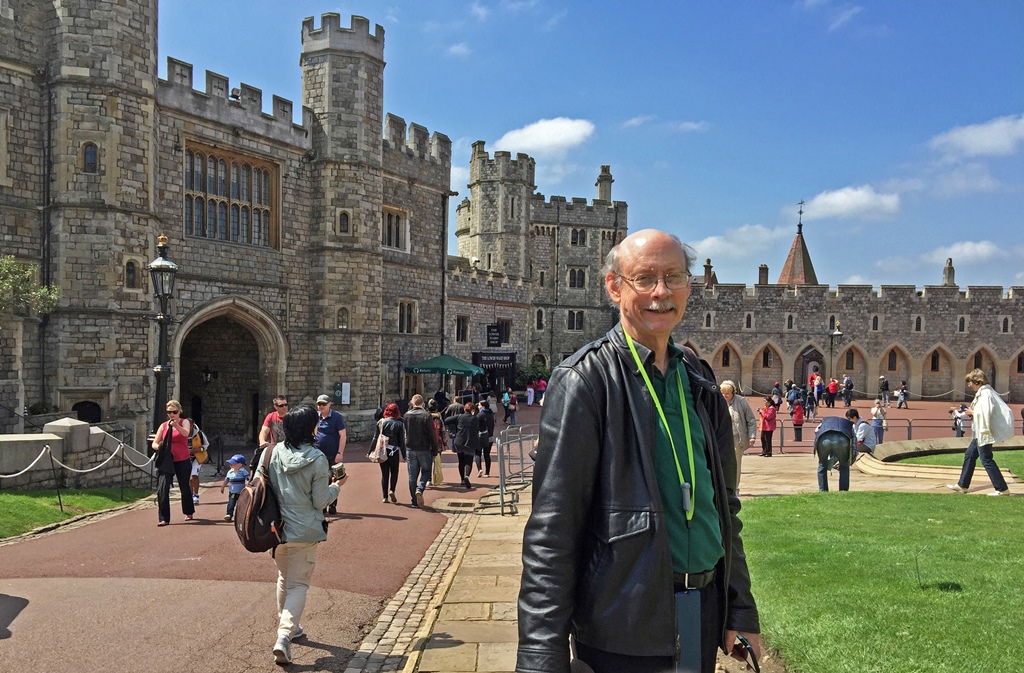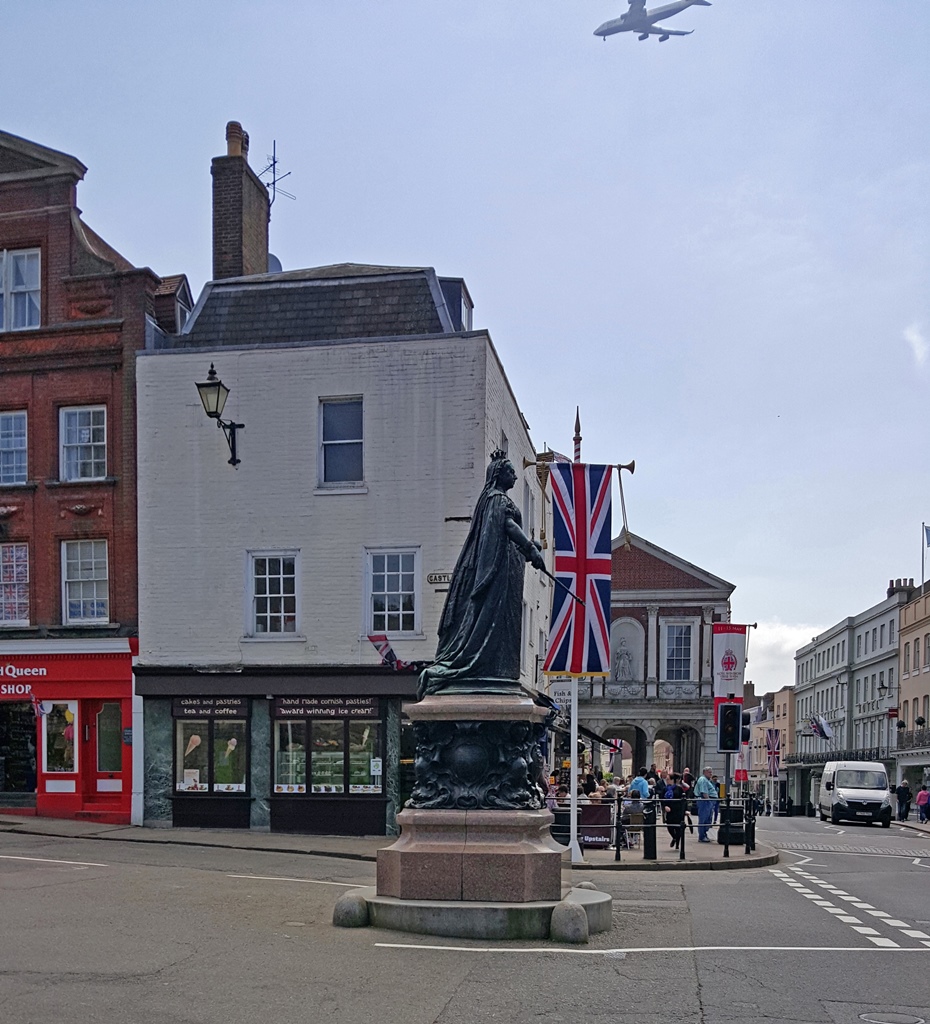For our next day in the U.K., we'd signed up for a day tour that would take
us outside the city of London, to points of interest that might have been
complicated destinations if we'd attempted them on our own. From the page
title, you've undoubtedly deduced that the first of these destinations was
Windsor Castle,
about which I'll have plenty to say below. We'd found and pre-paid for
the tour on the Viator website. To
join our tour, we needed to present ourselves at the Victoria Coach
Station by 8:30 A.M. Being late would cause us to miss our tour and to
lose the fee we'd already paid, so we were motivated to be on time.
Fortunately this was not a problem, as the Victoria Coach Station was a
short walk from the Victoria Station Underground station, and we left
ourselves plenty of time to get there. The Coach Station surrounded a
large parking area choked full of tour buses ("coaches" in the local
dialect), and the waiting area in the station was choked full of tourists
waiting to be assigned to the buses. Periodically a tour guide with a
clipboard would announce a tour and read a list of names, and the
enumerated tourists would march dutifully to the appointed bus, which
would eventually find its way out of the station and disappear into the
wilds of greater England. When our turn came, we boarded without
incident and made our way in a generally westward direction toward
London's outskirts, passing some interesting buildings along the way.
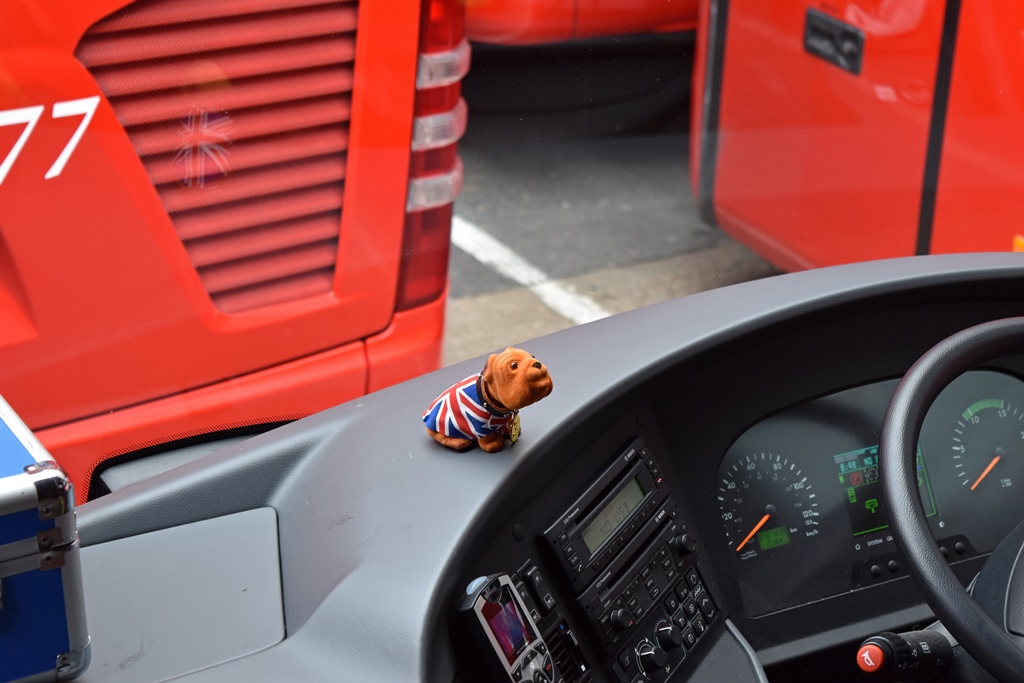
Guardian Angel on Tour Bus Dashboard
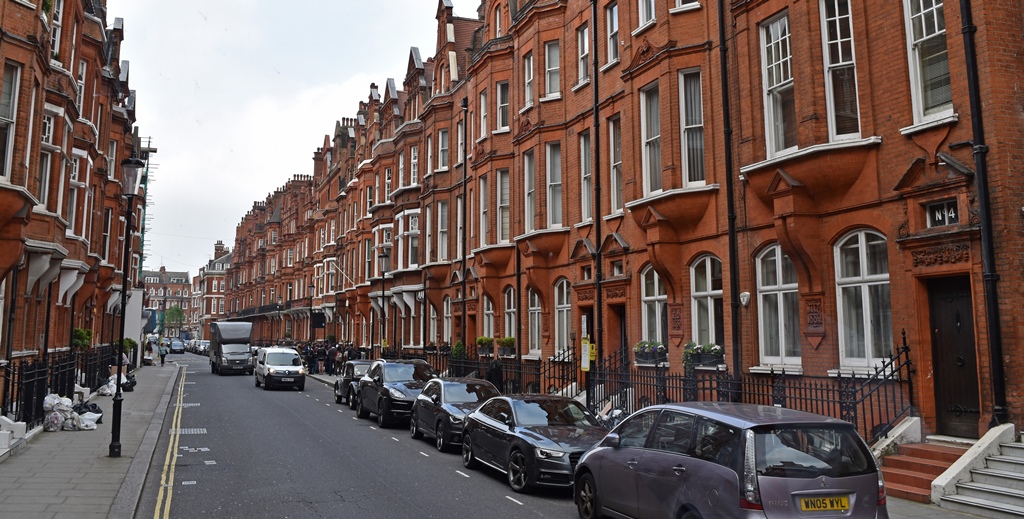
Brick Apartment Buildings
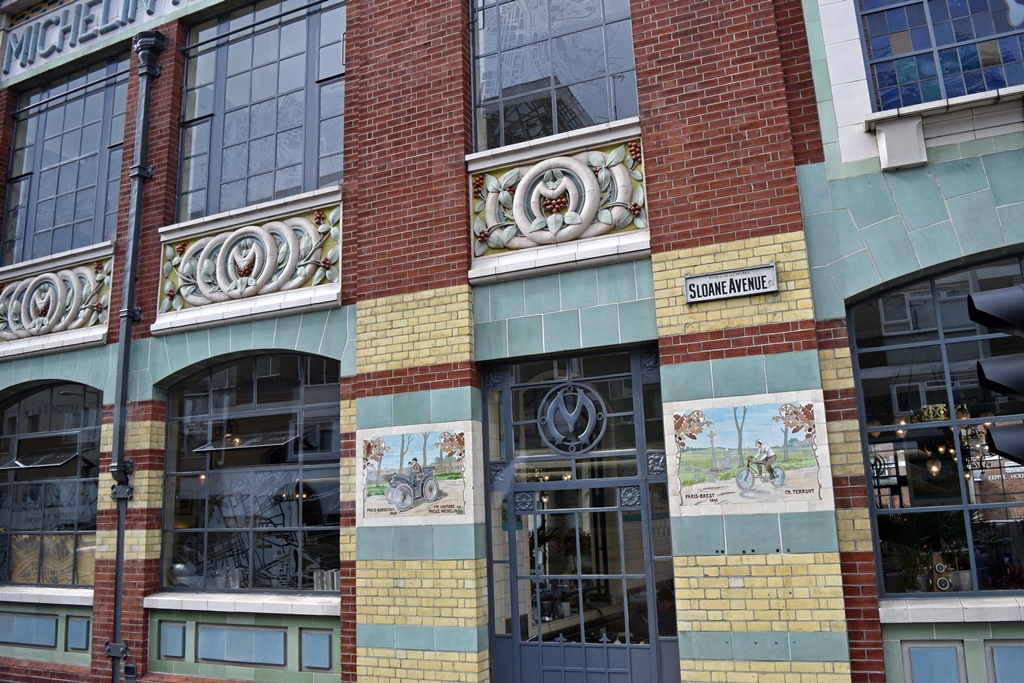
Old Michelin Tyre Co. Building
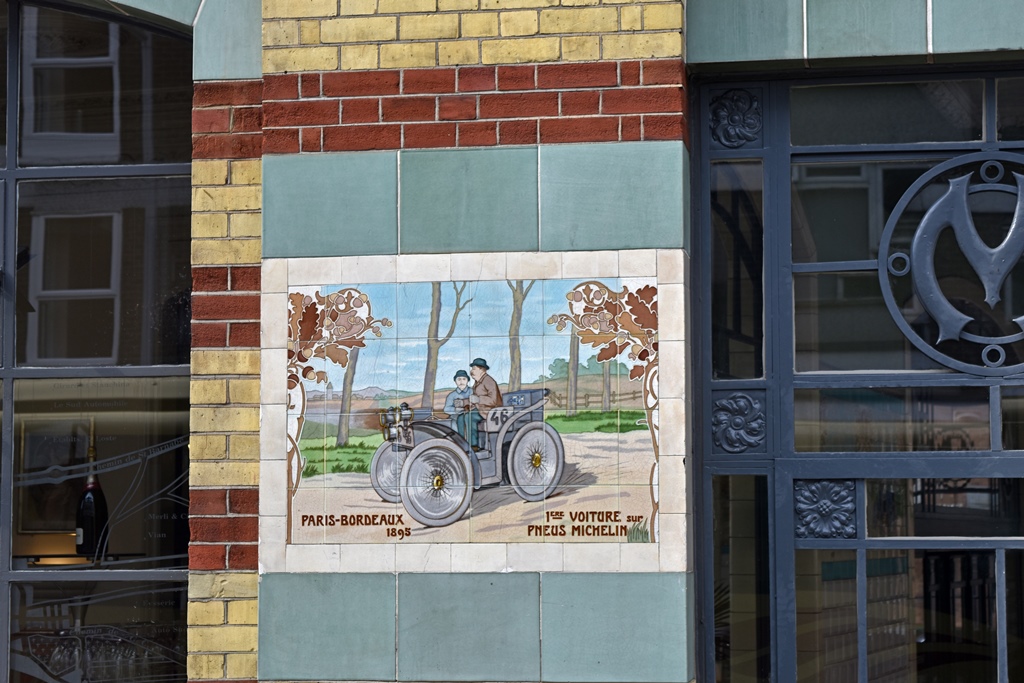
Detail, Old Michelin Tyre Co. Building
On one of the buildings we passed, we noticed a sort of a blue plaque
announcing that the late film director Alfred Hitchcock had lived there
for a number of years. London is full of history, and the management
is not shy about calling attention to it – there are blue plaques all
over town, identifying locations where historical incidents had
occurred, or where famous people had lived while doing famous things.
Alfred Hitchcock Plaque
Windsor Castle was established late in the 11th Century by William the
Conqueror as one of several castles that were built around the outskirts
of London. It was originally built of timber in a strategic location on
the bank of the River Thames, a couple of miles upstream from a settlement
called Windsor which had existed for about 300 years. In the 12th Century,
the castle became a royal residence under Henry I, and a settlement
started to grow around the castle which came to be called "New Windsor".
Over time the newer settlement appropriated the Windsor name, probably
when it wasn't so new anymore, and the older settlement came to be called
"Old Windsor", a name it retains to the present day. Also over time, the
castle transitioned from a timber fortification to one of stone, and new
structures appeared within its walls, while old ones were replaced or
improved upon. Today the castle is the longest-continually-occupied
castle in Europe and is the place where Queen Elizabeth generally spends
her weekends. It is also a magnet for curious tourists.
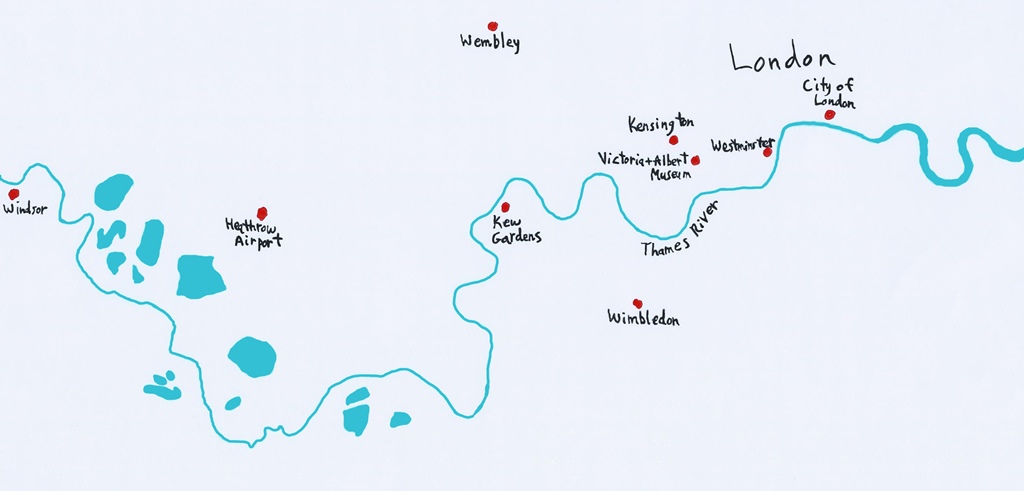
London to Windsor
Like us, obviously. As we pulled into town, there was no mistaking
the town's main tourist attraction.
Windsor Castle from the West
Bus parking was down a hill from the Windsor train station, which wasn't
that big from a railway point of view (I think there were only one or two
platforms), but which offered many opportunities for visitors to buy
souvenirs or fast food.
Windsor Train Station
We followed our guide past all the shops and came out next to the castle.
We followed the external wall eastward, passing an elaborate gate along the
way. The gate was called the King Henry VIII Gate, because it was built
under the command of King Henry VIII.
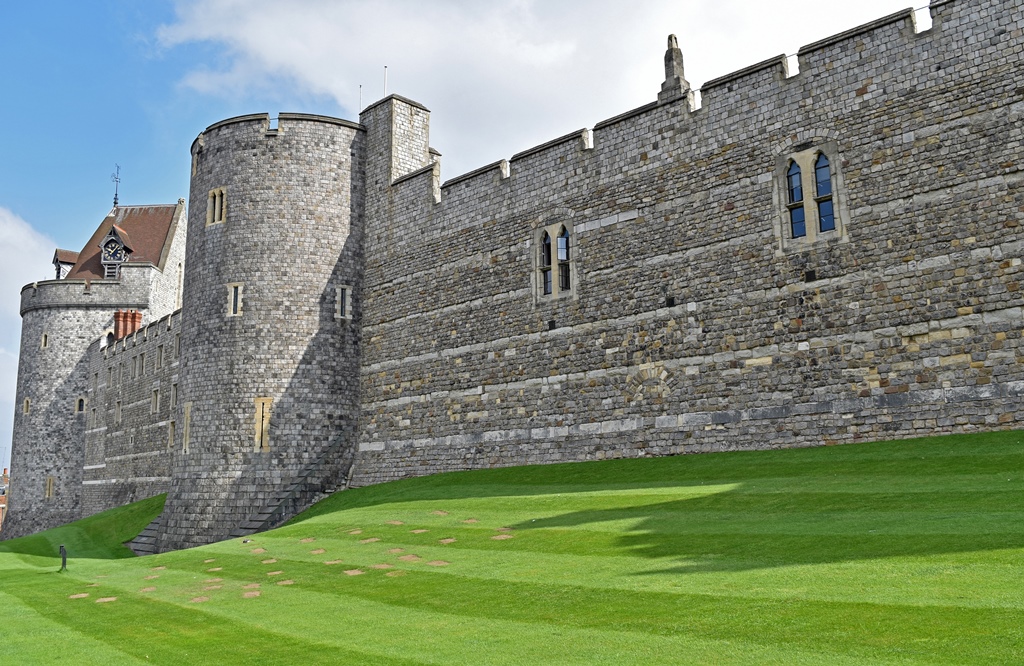
Castle Wall and Towers
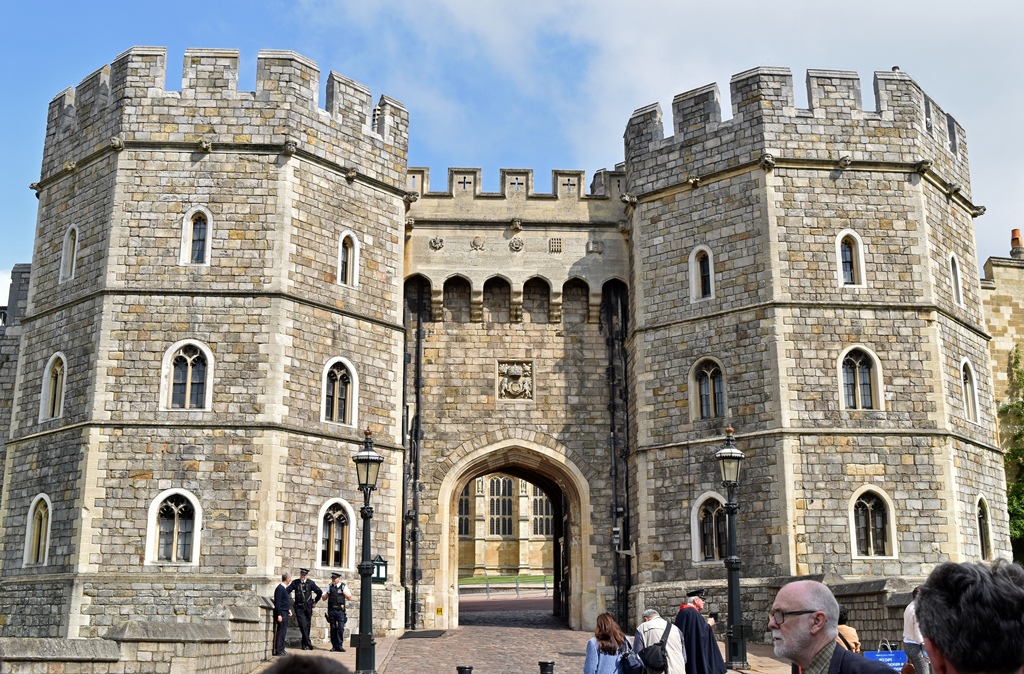
King Henry VIII Gate
We paused for a while outside a ticket office while our guide did whatever
he needed to do to make sure we could all get into the castle. Then we
headed toward the entrance, which was farther to the east.
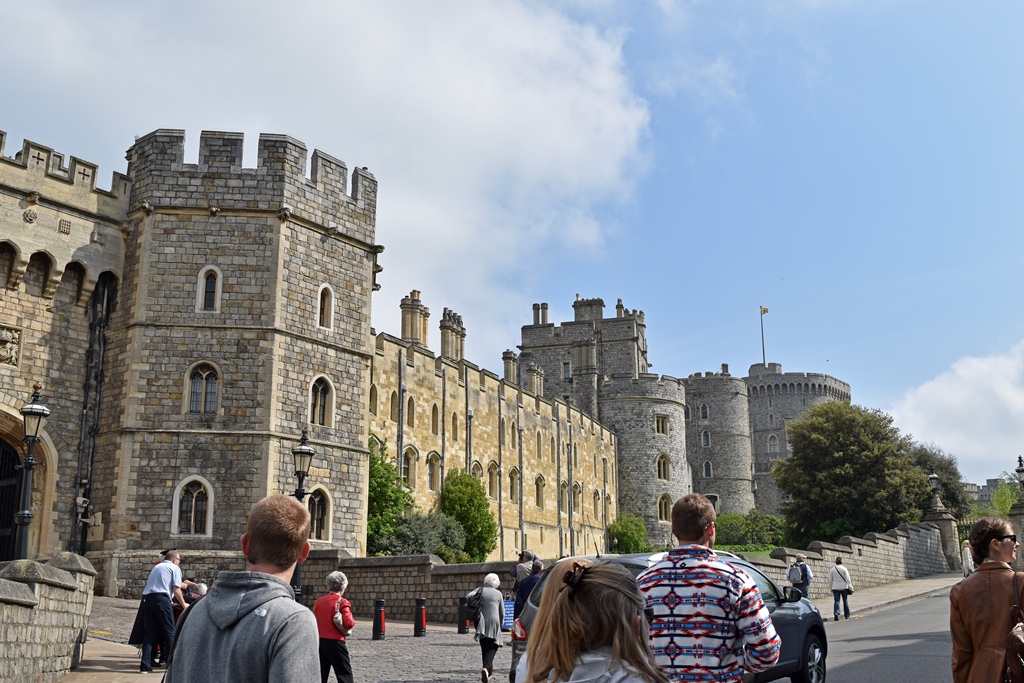
Castle Structures
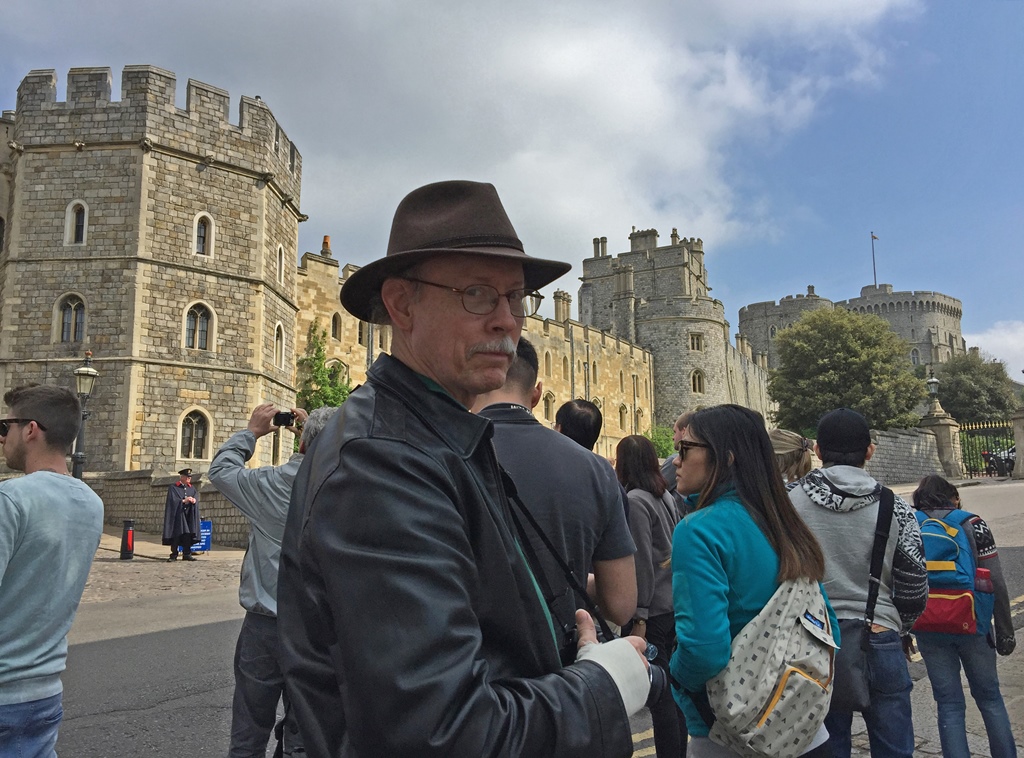
Bob and Castle
Windsor Castle is split into three main areas. There's the Upper Ward (B in
the diagram below), which consists of a large, grassy courtyard, surrounded
by rooms of state and of habitation. The inhabitants include the Queen and
members of the royal family when they're in residence. Tourists aren't
allowed into the courtyard or any of the rooms of habitation, though there
was a gate through which we could see some of the courtyard. Then there's
the Lower Ward (F in the diagram), which has a lesser elevation than the
Upper Ward. This is largely another open area, which I'll discuss below.
And finally, there's the Middle Ward (labelled M), which is aptly named, as
it's between the Upper Ward and the Lower Ward. The Middle Ward is mostly
notable for being the location of the Round Tower (A).
Windsor Castle Plan
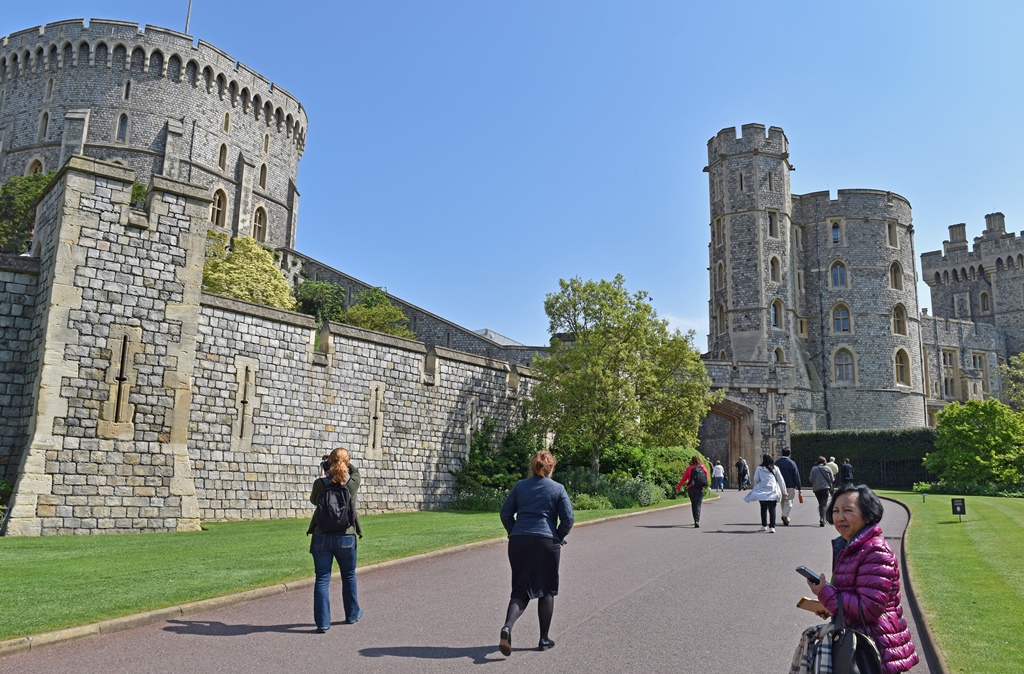
Nella with Round Tower, Edward III Tower and St. George's Gate
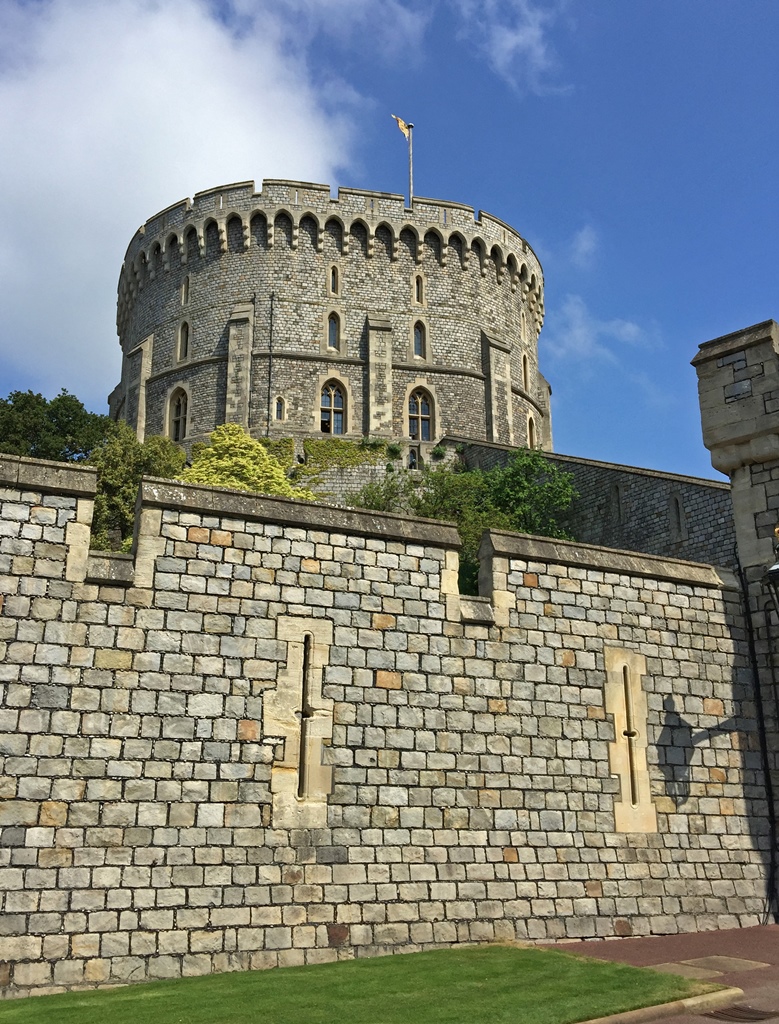
Round Tower
The Round Tower isn't quite exactly round, but is generally rounder than the
castle's other towers. It's also taller, as it was designed partly as a
lookout point (though it didn't reach its present height until the 19th
Century, when 30 feet were added during a renovation ordered by George IV).
It's built on top of a hill in the middle of the castle and was one of the
castle's original structures, when it also functioned as the castle’s Keep
(a defensible structure that everyone could run to when things got
dangerous). There's a flagpole on top of the Round Tower, which normally
flies either the Union Jack or a flag known as the Royal Standard. When
the Royal Standard is flying, this means the country's monarch is in
residence. During our visit, the Royal Standard was flying, but the Queen
did not come out to hang with the tourists. She might've had some other
things to do.
Round Tower with Royal Standard
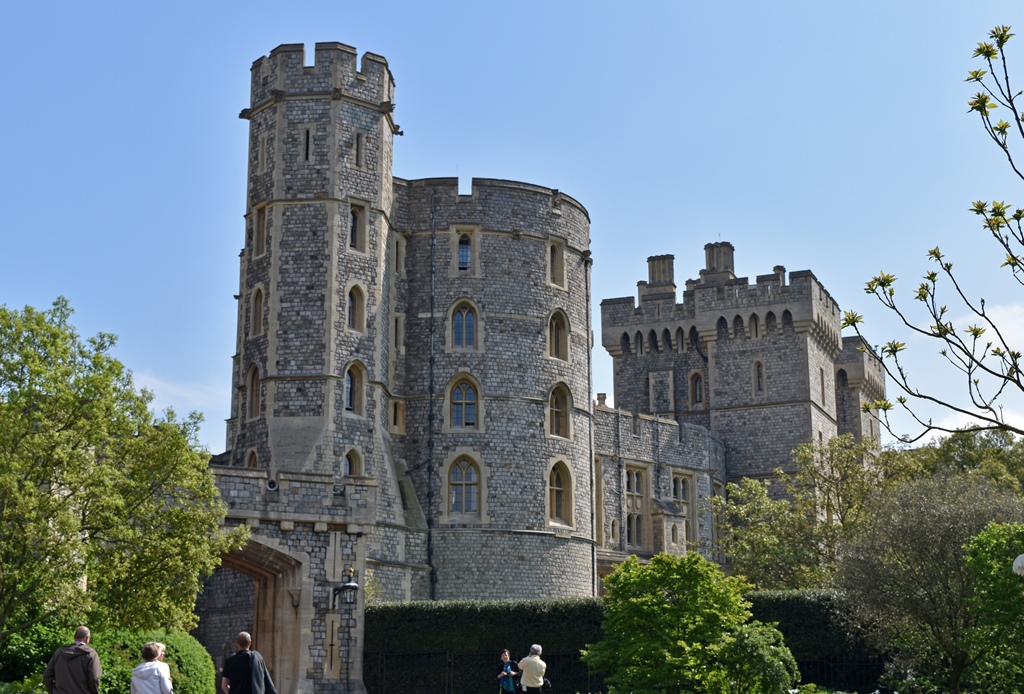
Edward III Tower, St. George's Gate and Lancaster Tower
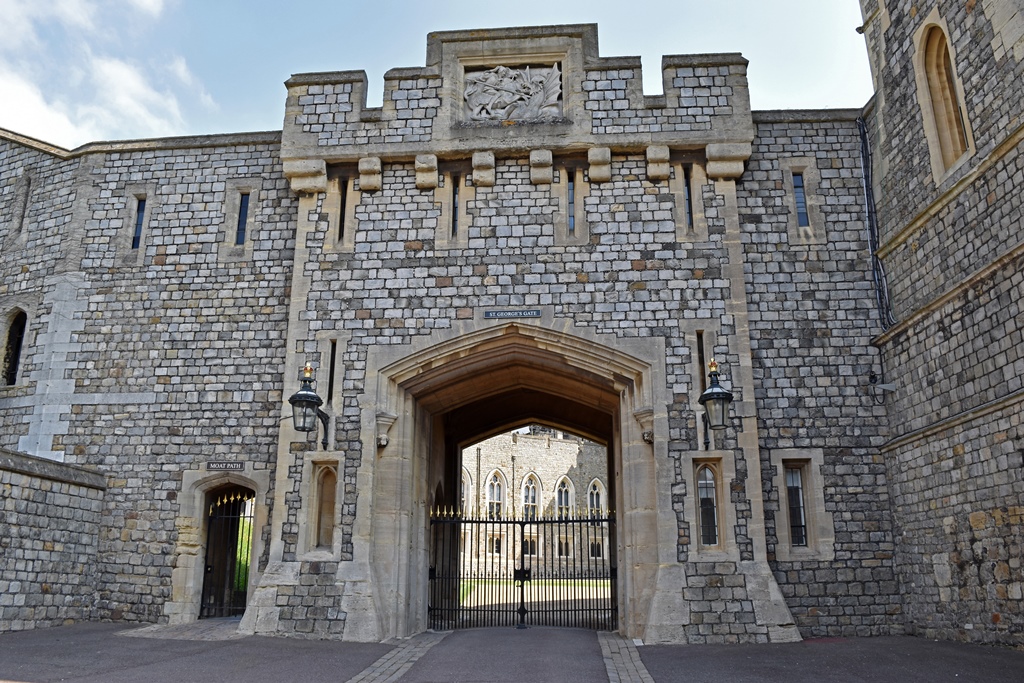
St. George's Gate
The entrance to the castle pointed us toward the impassable gate into the Upper
Ward. Since the gate was impassable, we turned left and followed a walkway
toward the Lower Ward. On the way, the walkway curved around the Middle Ward,
and on reaching the Lower Ward, we could look back and see that the part of the
Middle Ward not occupied by the Round Tower was nicely landscaped.
Inside Castle Wall, Heading West Toward Lower Ward
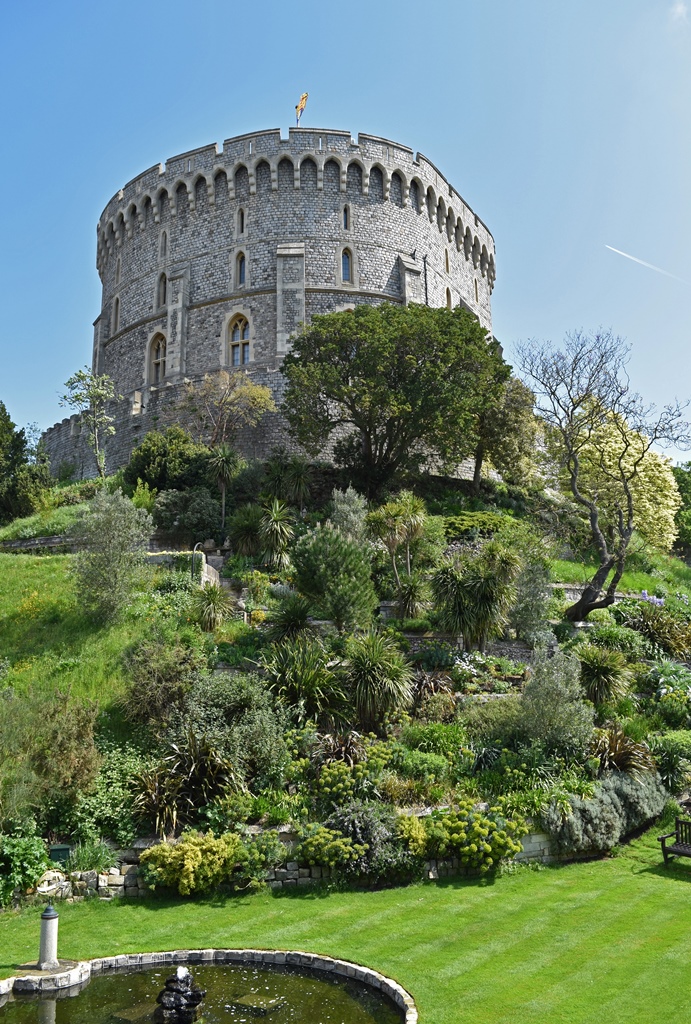
Round Tower and Landscaping
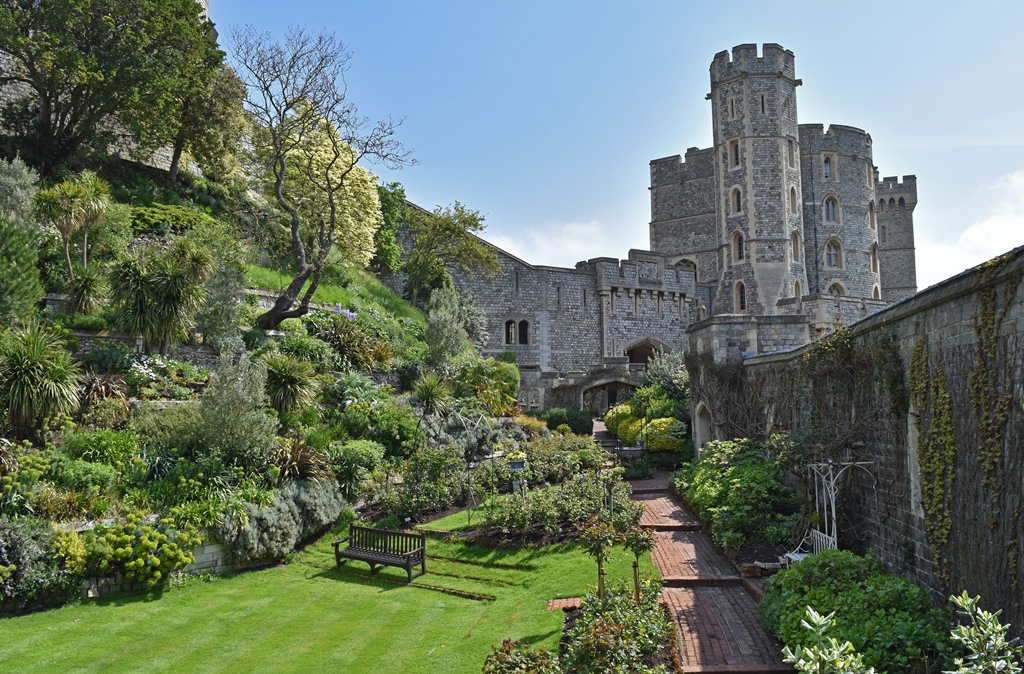
Edward III Tower and Landscaping
The Lower Ward is home to St. George's Chapel (a church that's been there
since 1511) and a large open area. The open area was available for
visitors to walk around in, and a whole lot of them were doing just that,
or more specifically they were mostly attempting to get into suitable
positions for viewing a ceremony that was going on. This was the
Changing of the Guard, which takes place each day at 11 A.M. In the
Changing of the Guard, a new group of guards starts marching from its
Windsor barracks at 10:45 and arrives at the castle at 11 to begin the
ceremony relieving the previous group of guards. When we showed up,
there were two subgroups of guards arrayed in front of us. One wore red
coats and tall furry black hats, and was armed with automatic weapons
tipped with bayonets. The other group wore green jackets and kilts and
was armed with bagpipes, with which they began to blow a catchy tune.
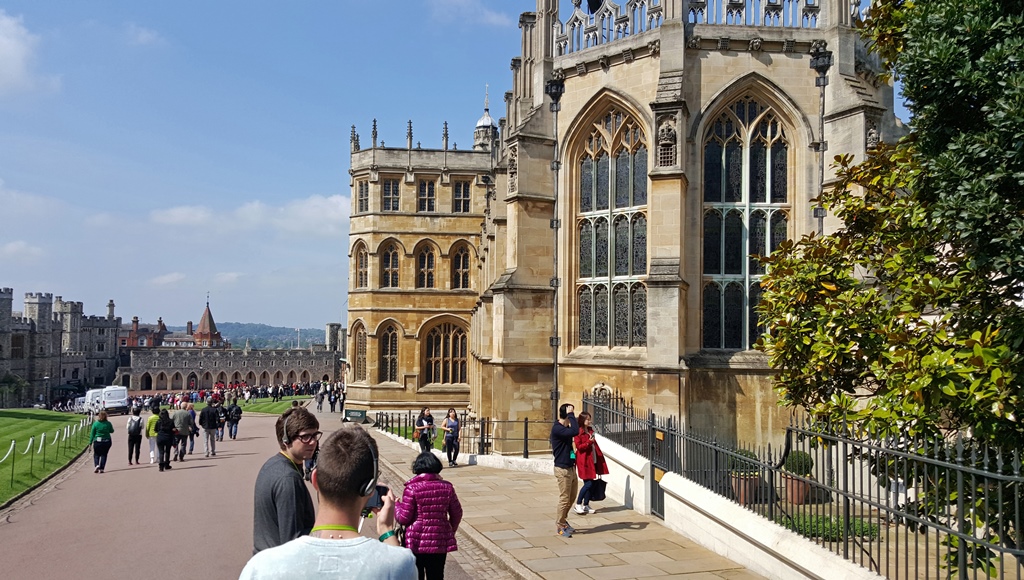
St. George's Chapel and Lower Ward
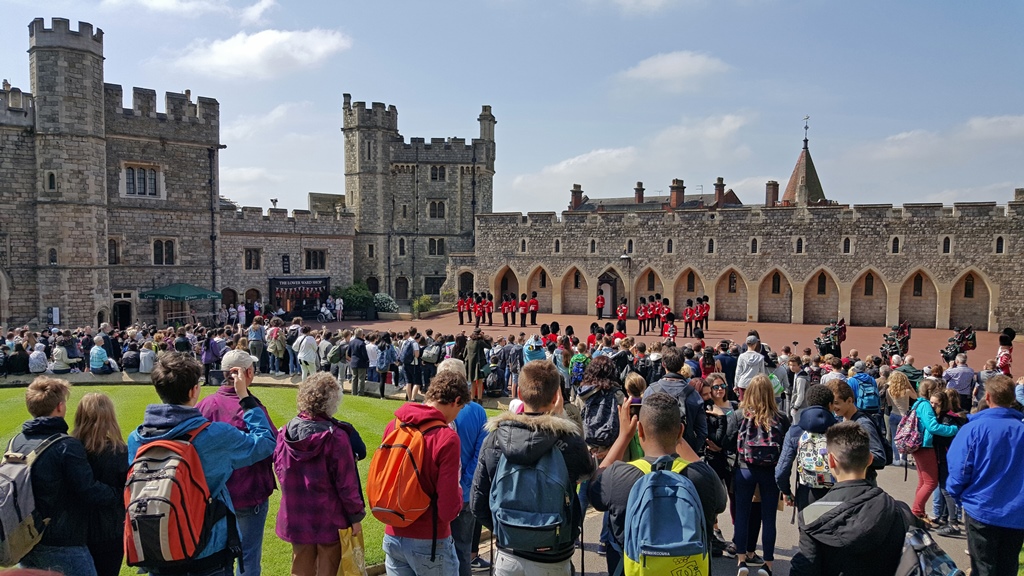
The Changing of the Guard, Lower Ward
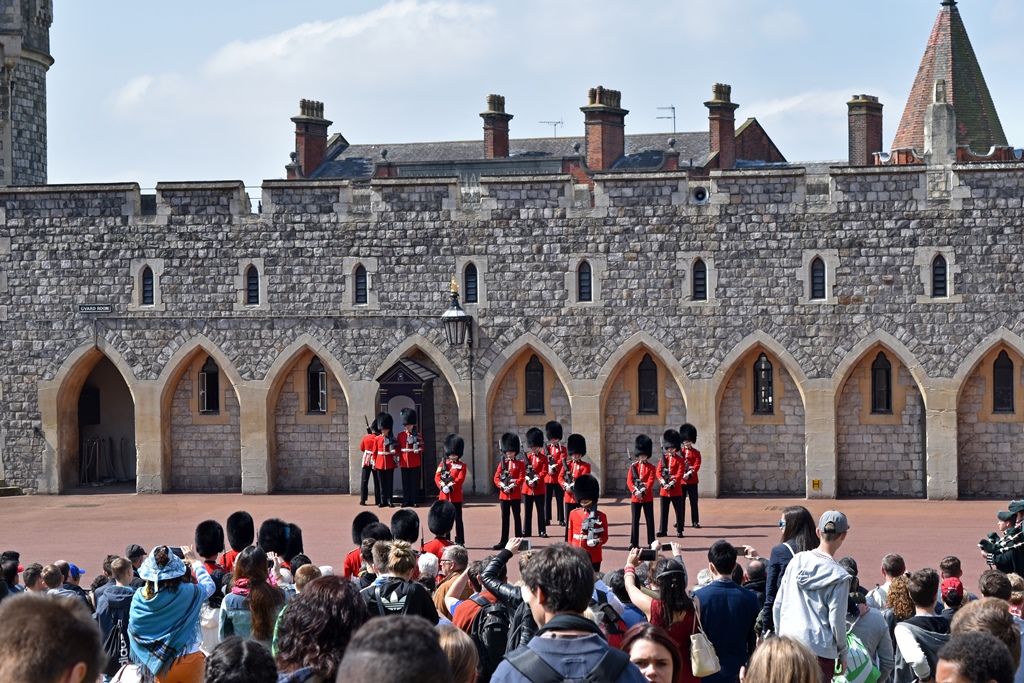
The Changing of the Guard - Foot Guards

The Changing of the Guard - Musical Interlude
We didn't stay for the whole ceremony, as we'd only been given until noon to
look around and get back to the bus, and there was still much to see. First
we headed for St. George's Chapel, which was next to us. A chapel had been
on the site since the 13th Century, but the present structure was built
between 1475 (under Edward IV) and 1511 (under Henry VIII).
St. George's Chapel
St. George's is a high-medieval Gothic church, and has been the site of many
weddings, including those of the children of Queen Victoria, and more
recently, that of Prince Harry and Meghan Markle (2018). Prince Charles and
Camilla Parker Bowles received a blessing here from the Archbishop of
Canterbury in 2005, after being married in a civil ceremony at the Windsor
Guildhall. The chapel has also been the site of many burials. A partial
list includes Edward IV (1483), Henry VIII (1547), Jane Seymour (1537),
Charles I (1649), George III (1820), George IV (1830), George V (1936),
George VI (1952) and Princess Margaret (2002). We weren't able to take
pictures in the Chapel, as this was not allowed. But here are some pictures
from the Internet:

Plan of St. George's Chapel
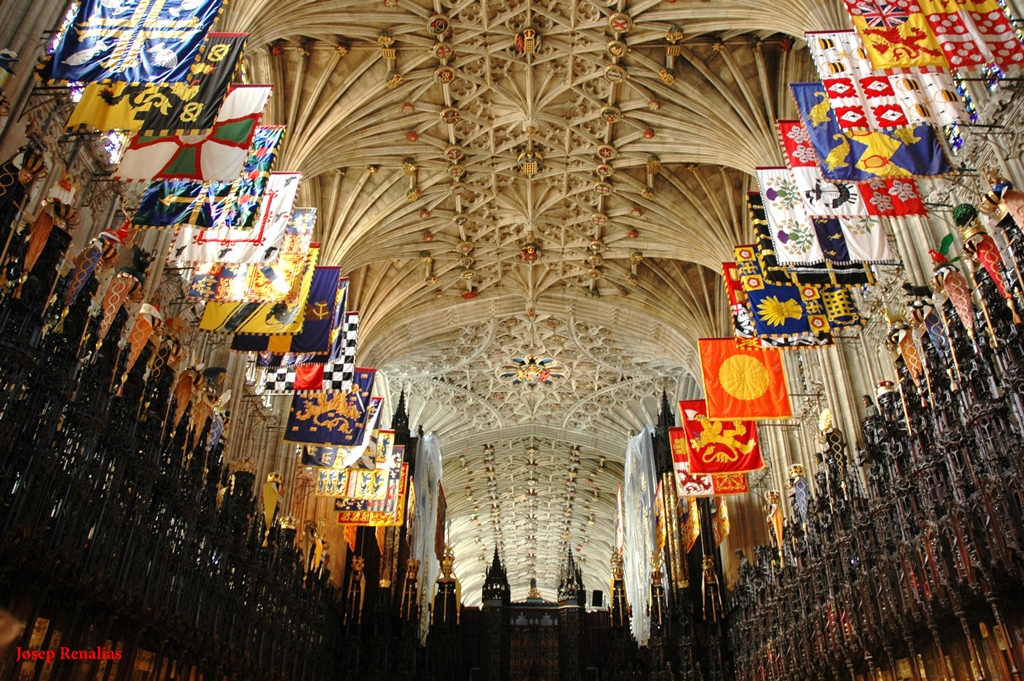
St. George's Chapel
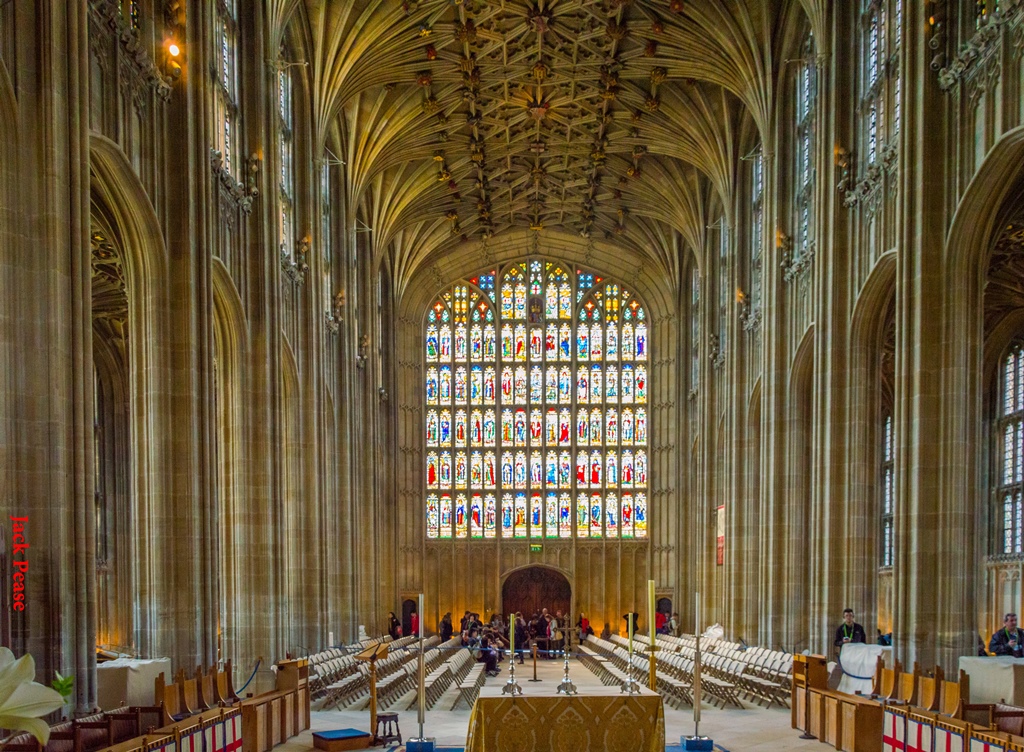
St. George's Chapel
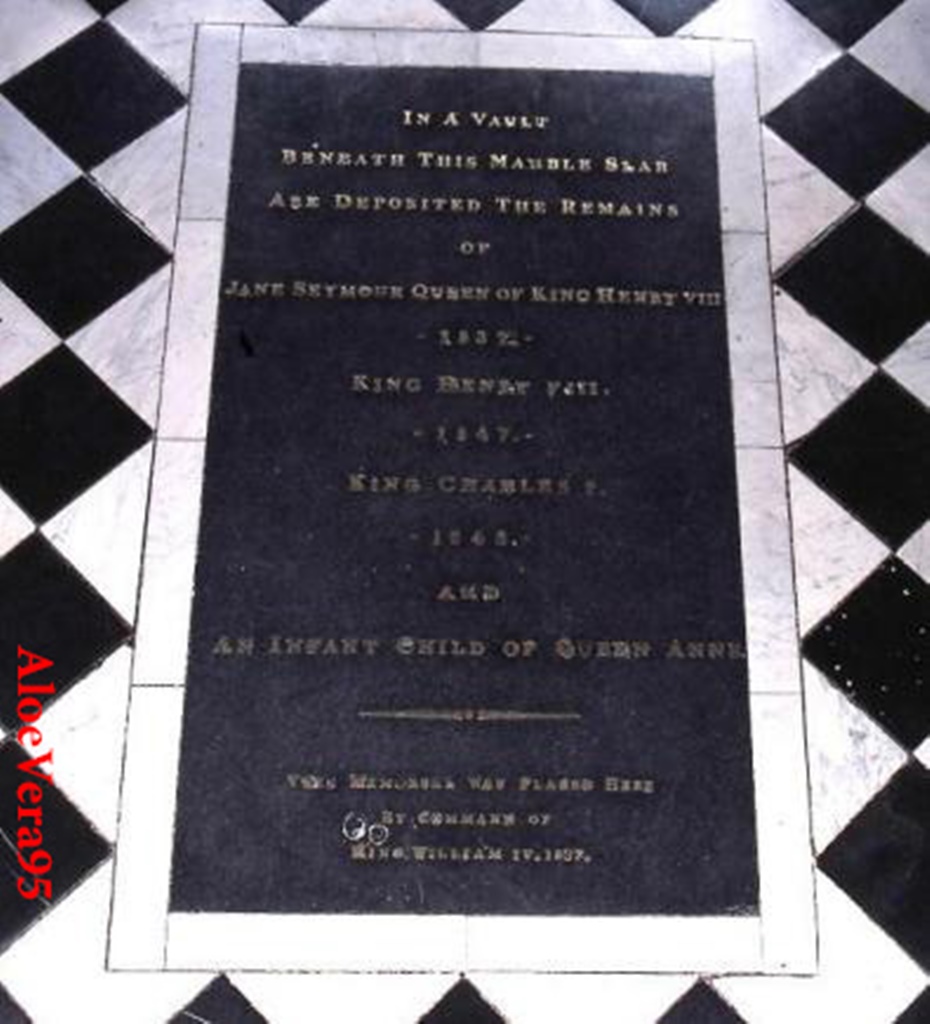
Tomb of Henry VIII, Jane Seymour and Charles I
From the chapel we headed back uphill toward the Upper Ward. While we couldn't
enter the grassy courtyard or the residence rooms, some of the State Apartments
(C in the diagram above) were open to visitors.
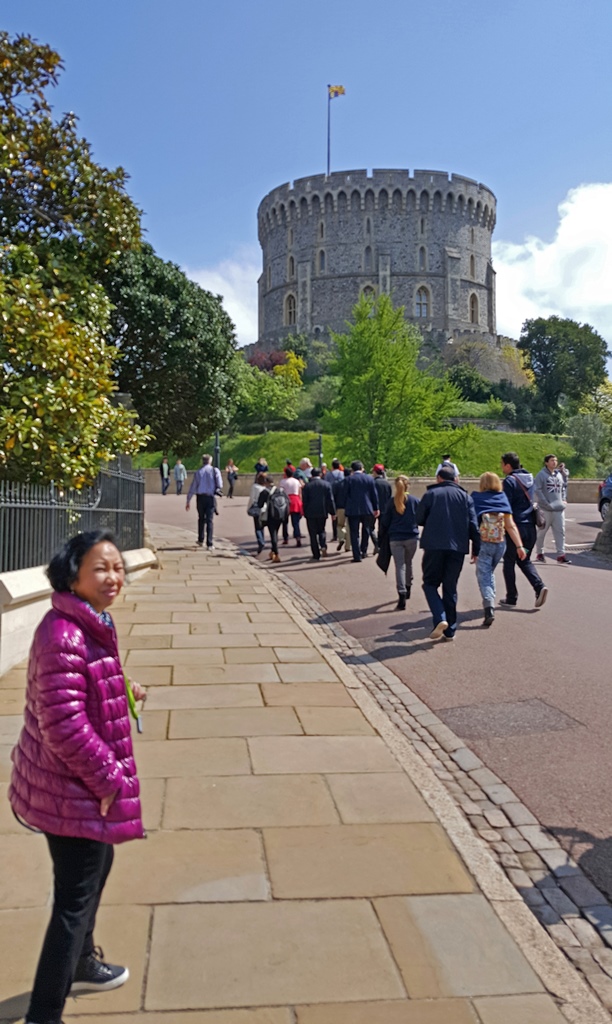
Nella and Round Tower
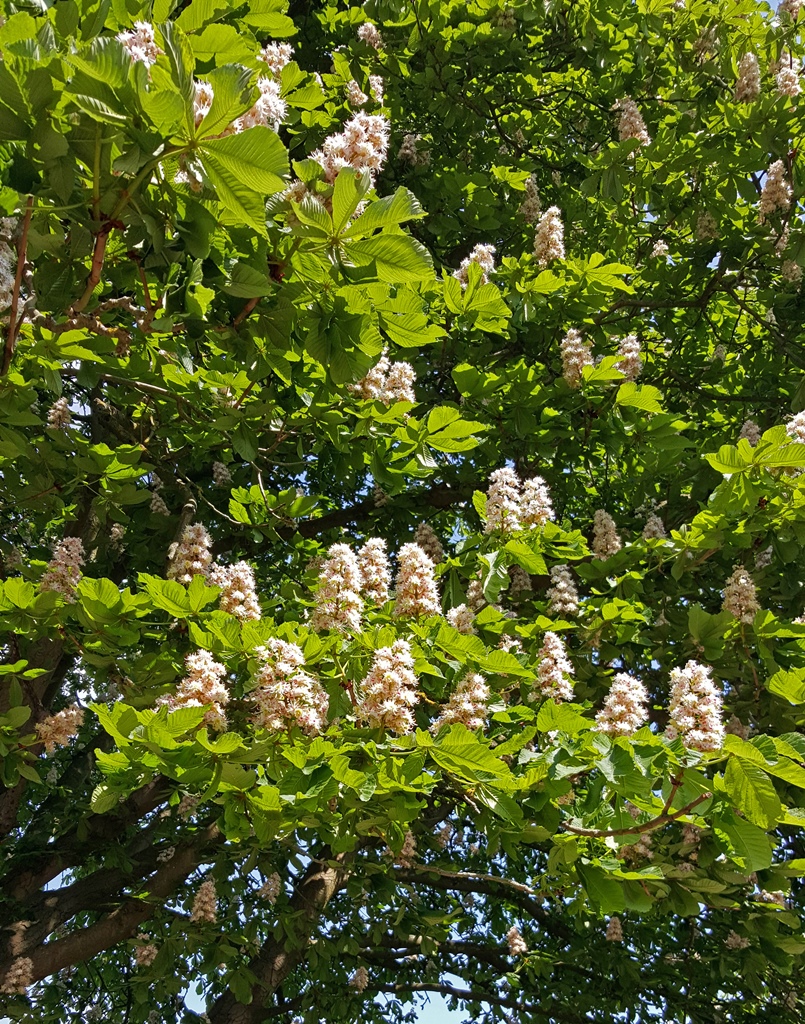
Flowering Tree
We joined a short line to get into the State Apartments and had a nice look
around. The rooms were quite impressive. Again, photography was not allowed.
And again, here are some photos from the Internet:
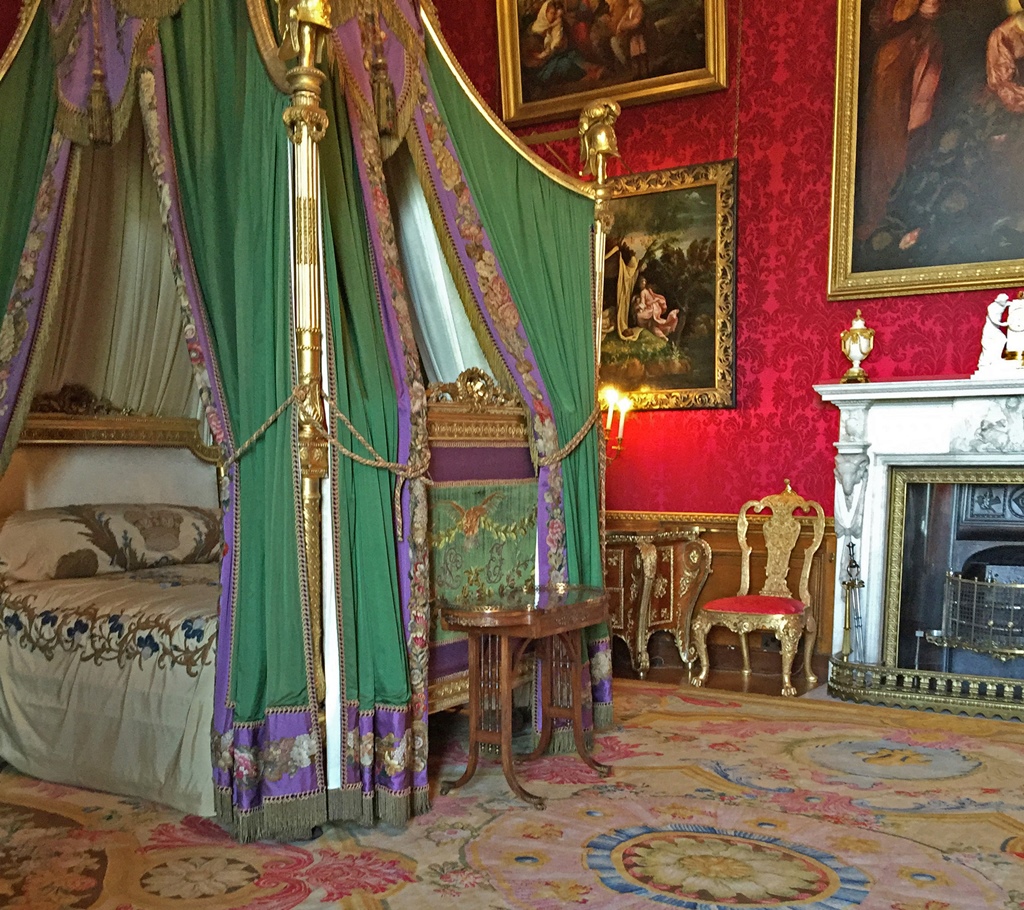
King's Bed Chamber
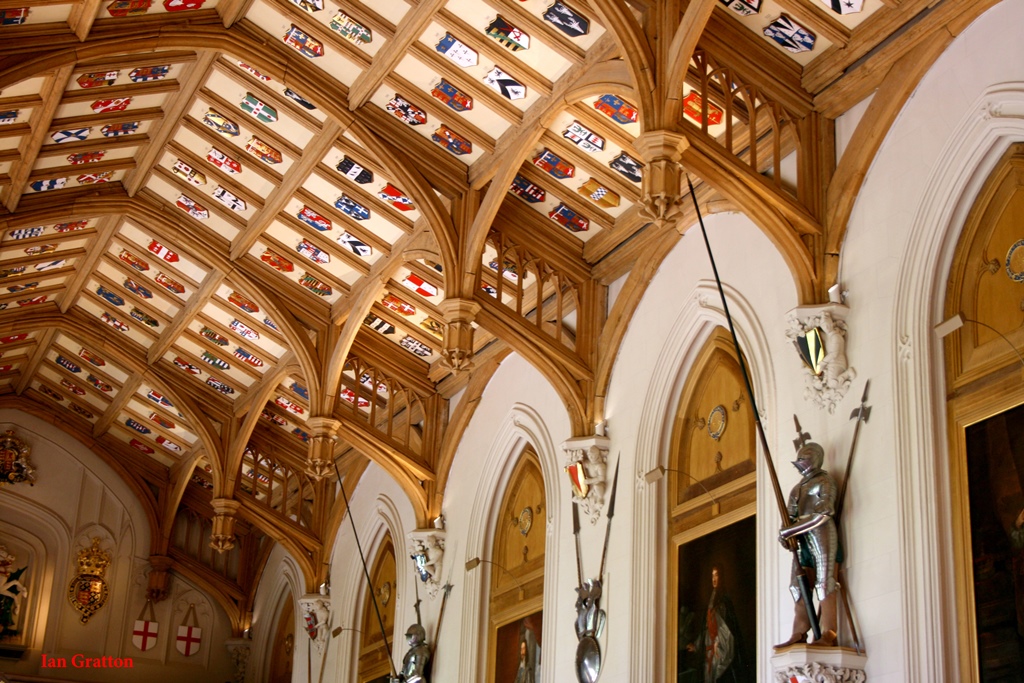
St. George's Hall
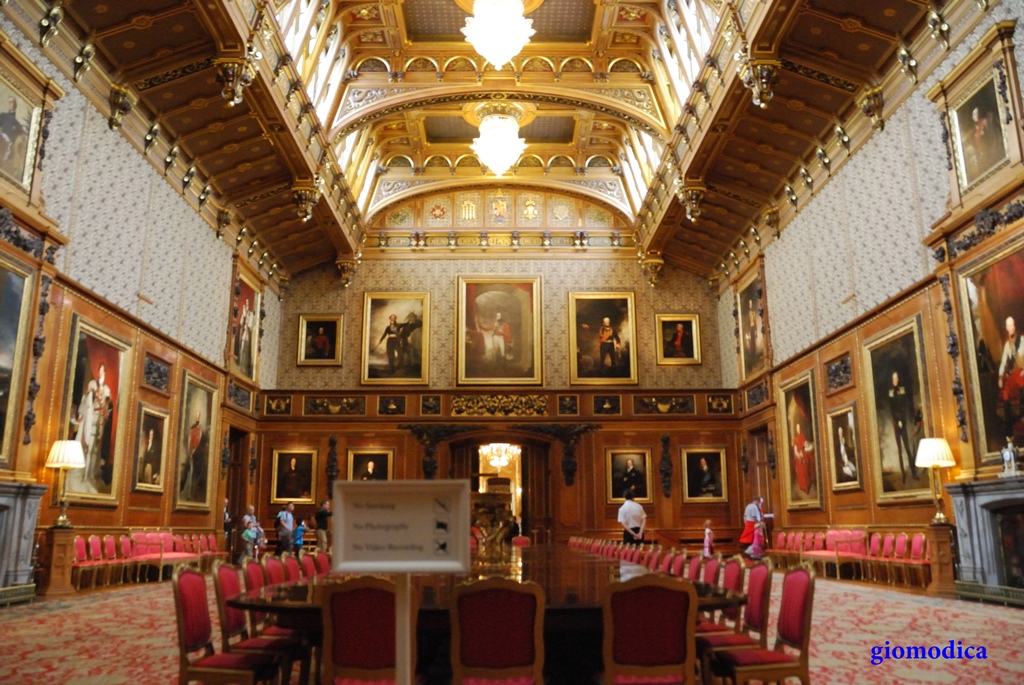
Waterloo Chamber
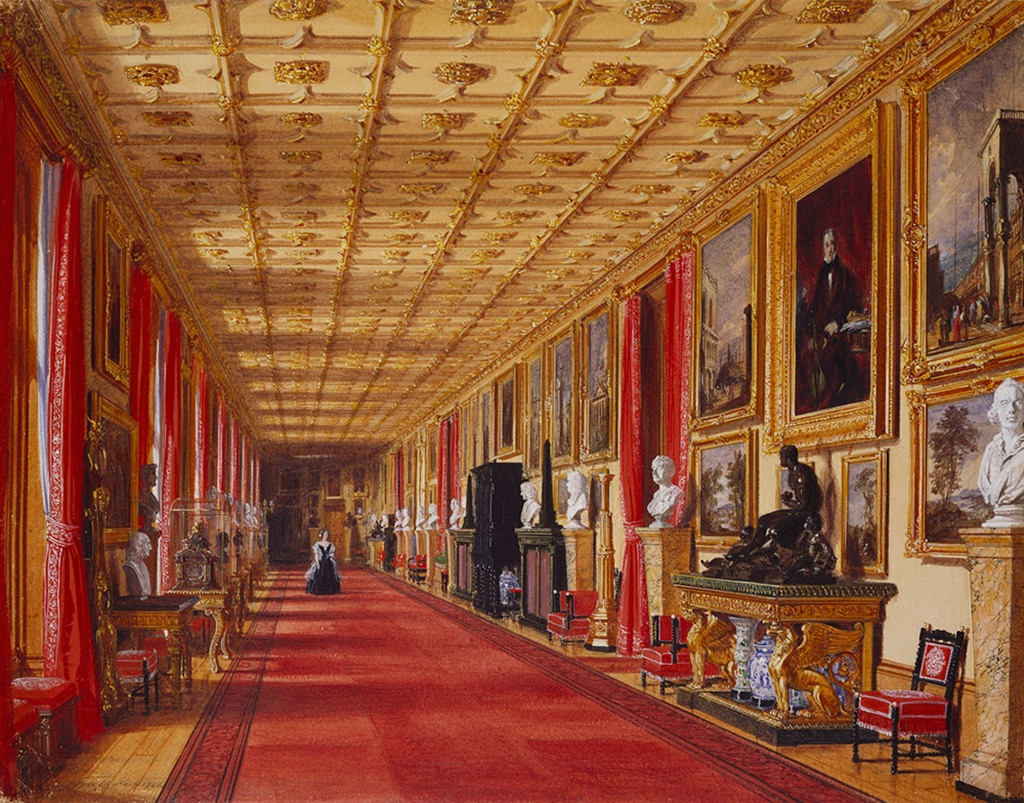
Grand Corridor, Joseph Nash (1846)
We emerged from the State Apartments and calculated that we'd better start
back toward the bus to avoid being left behind. This took us back down to
the Lower Ward, as the exit was at the Henry VIII Gate. This is also where
we had to return the audioguides we'd picked up on the way in.
Bob with King Henry VIII Gate
We returned to the bus the way we'd come, passing back through Windsor and its
Central Station.
Queen Victoria Statue and Heathrow Airplane
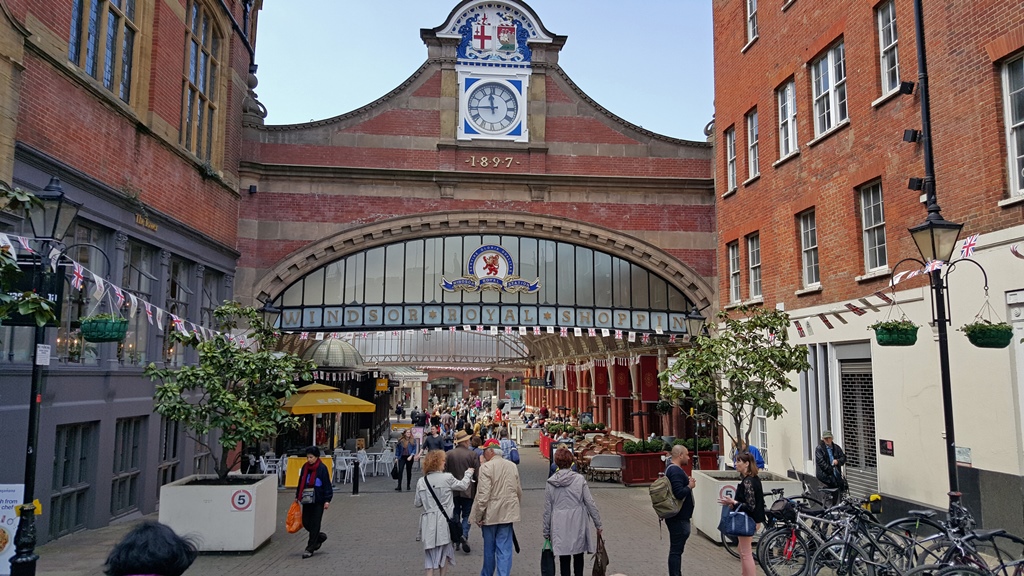
Shopping Area at Central Station
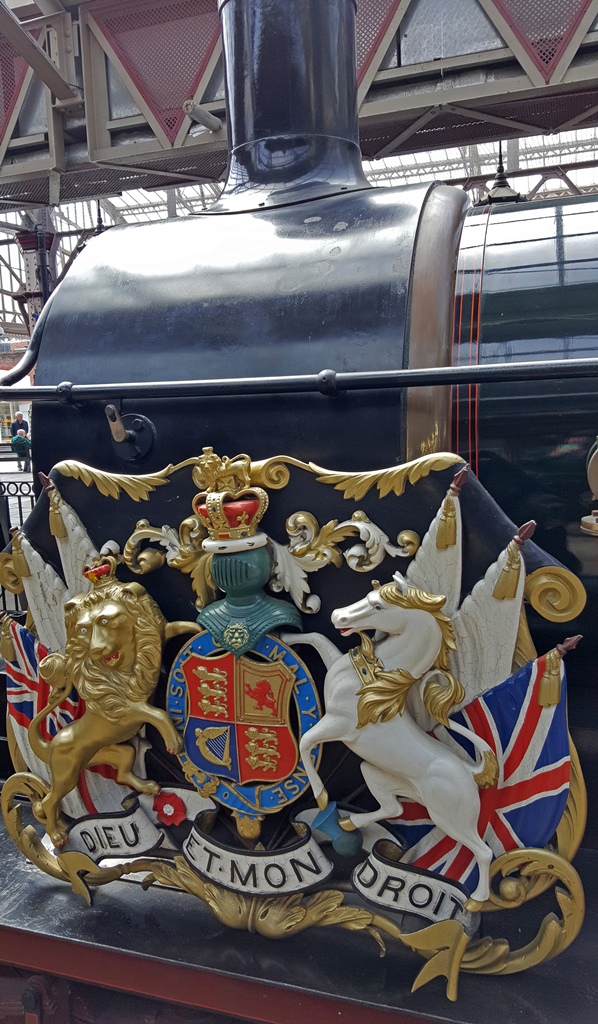
1894 Locomotive
We made it back to the bus with a few minutes to spare, and after the rest
of our group returned as well, the bus driver started up the bus, and we
headed out for our next destination: the ancient city of Bath.





